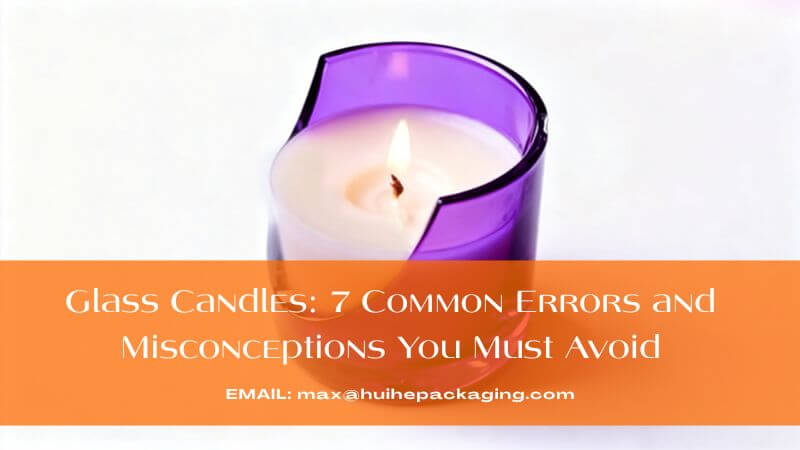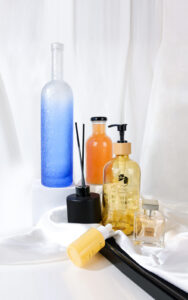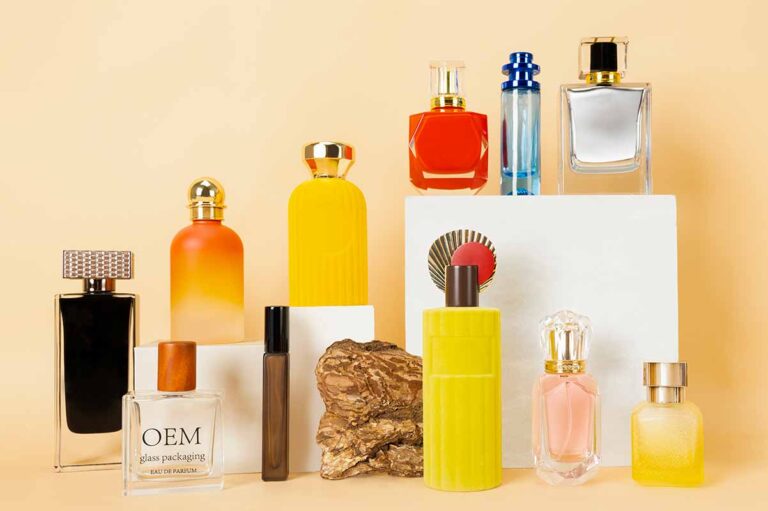Glass candle jars have never been more popular — from home décor trends to luxury-brand candles, their clean lines and elegant transparency make them a go-to choice. According to recent market data, the global scented candle market is expected to grow at a CAGR of over 8% in the next few years, driving demand for high-quality glass candle containers. But as more people dive into candle making or sourcing, many unintentionally pick the wrong glass vessel. Misconceptions like “any jar will do” or “thicker glass is safer” lead to cracked jars, dangerous failures, or poor performance. In this post, we’ll uncover 7 common errors and misconceptions around glass candle jars — and explain how you can choose truly safe, reliable, heat-resistant candle glass for your products or personal DIY projects.
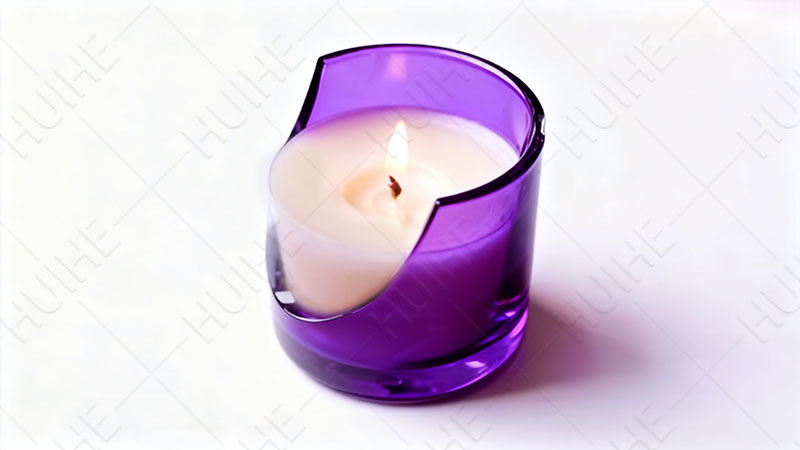
Common Misconceptions About Glass Candle Containers
1. “Any Glass Jar Can Be Used for Candles”
One of the biggest mistakes candle makers make is assuming that any glass jar is safe for candles. In reality, not all glass is created for high heat. Standard soda-lime glass, especially food jars or recycled drink bottles, is not designed to handle constant temperature changes. When exposed to the heat of a burning candle — and later to rapid cooling — the glass can experience thermal shock, leading to cracks or sudden breakage.
Heat-resistant candle containers, such as those made from properly annealed soda-lime glass or borosilicate glass, are engineered to distribute heat evenly and withstand temperature swings during burning. This is why professional candle jar manufacturers follow strict molding and annealing processes.
2. “Thicker Glass Is Always Better”
It’s easy to assume that thicker glass must be safer, but this isn’t always true. While a certain level of thickness is necessary, excessively thick walls can trap heat, creating uneven temperature distribution. When the heat builds up inside a thick glass wall, the outer surface cools faster than the inner surface, increasing stress and making the container more prone to cracking.
For most candle applications, a 3–5 mm wall thickness offers the right balance between strength, heat tolerance, and controlled thermal expansion. Instead of chasing the thickest jar, focus on choosing containers with uniform wall thickness and a stable bottom design, which matter far more for safe candle burning.
3. “Glass Candle Jars Can Be Reused Forever”
Many people love the idea of reusing candle containers, but unlimited reuse can be unsafe. After repeated heating and cooling, glass can develop micro-cracks that are invisible to the eye. These small fractures weaken the structure and increase the risk of failure during the next burn.
Wax, fragrance oil, and soot residue can also build up inside the jar, affecting wick performance and creating unexpected hot spots.
If you want to reuse jars, make sure you:
- Clean them with warm water and mild soap (avoid extreme temperature changes)
- Check for chips, scratches, or small cracks
- Avoid reusing jars that feel thin, lightweight, or uneven
For brands that want a reusable packaging concept, it’s better to choose professionally made candle containers designed for repeated heating, which suppliers like HUIHE PACK can provide in bulk.
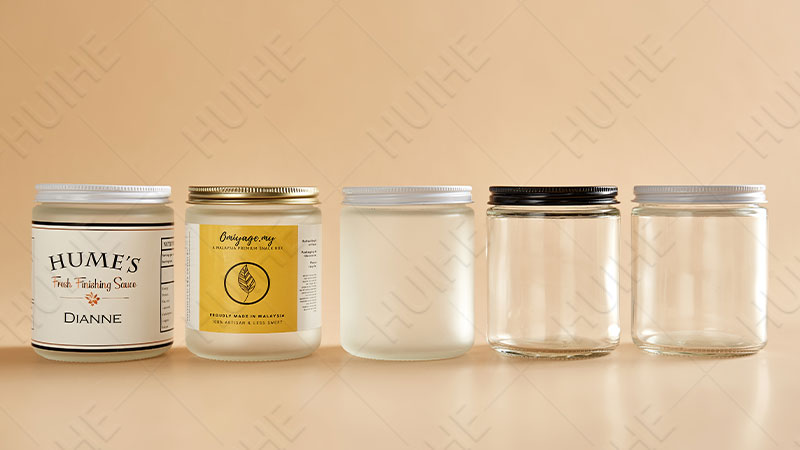
4. “Colored Glass Does Not Affect Burning”
Many candle brands love colored or coated jars, but the color does affect heat behavior. Dark or heavily coated glass absorbs more heat, which can raise the internal temperature of your candle and make the jar hotter than expected. This is especially noticeable with black, amber, cobalt, or deep green candle containers.
When you’re planning a candle line with dark glass, consider using:
- Lower-temperature waxes
- Smaller wicks
- More controlled fragrance load
For most candle makers, clear and frosted jars remain the safest and most stable options for consistent burning. If you need reliable transparent or matte-frosted candle glasses, HUIHE PACK offers a wide range of options suitable for both premium and mass-market candle lines.
5. “The Shape of the Jar Doesn’t Matter”
Shape plays a much bigger role in candle safety and performance than most people realize. A narrow-mouth jar restricts airflow, causing the flame to burn hotter and potentially leading to soot buildup. It can also trap heat at the top of the container. On the other hand, a wide-mouth jar improves ventilation and supports a more even burn.
For most candles, the safest and most efficient design is a wide base with a slightly tapered or gently open mouth. This promotes stable heat distribution, reduces tunneling, and minimizes overheating.
6. “Candle Jars Don’t Need Testing”
This misconception can be costly. All candle glass containers should go through strict testing, especially if you are selling to international markets. At HUIHE PACK, every candle jar batch goes through heat-shock tests, annealing checks, stress inspection, and real-burning simulations to ensure consistent performance.
7. “All Glass Suppliers Are the Same”
Price alone shouldn’t determine your choice of supplier. Low-quality candle jars made from poor materials, uneven walls, or improper annealing can lead to:
- Cracking or shattering
- Oil leakage
- Overheating
- Peeling color coatings or fading labels
Working with a reliable supplier ensures your candle line remains safe, stable, and consistent from batch to batch. With 16+ years of experience, exports to 50+ countries, and full OEM/ODM support, HUIHE PACK helps brands avoid the typical problems caused by low-grade candle packaging.
Choosing the right partner means fewer customer complaints, safer products, and a stronger brand reputation.
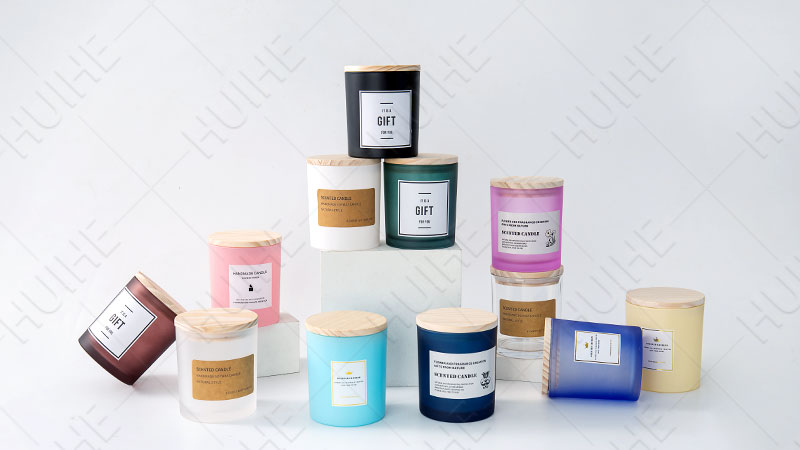
The Most Frequent Mistakes Candle Makers Make
Using Non-Heat-Resistant Glass
One of the most common mistakes is choosing glass that isn’t designed for high temperatures. Regular food jars, drink bottles, or lightweight craft containers often lack the heat-resistant properties needed for candle making. When exposed to a steady flame, they can develop stress points or suffer from thermal shock, especially if the environment changes quickly. If you want safe and reliable results, always use purpose-built candle containers made from well-annealed soda-lime or borosilicate glass.
Ignoring the Annealing Quality
Annealing is the process that removes internal stress during glass production. If this step is rushed or poorly controlled, the container may look fine but will fail under heat. Many candle brands overlook this detail, and it results in cracking, uneven burning, or unexpected breakage. When choosing candle jars, make sure your supplier provides consistent annealing quality, because stable stress distribution is the foundation of safe candle glass.
Wrong Wick Size Causing Overheating
Wick size has a direct impact on how hot the glass becomes. A wick that is too large produces a flame that burns hotter and faster, causing the wax pool to expand and the glass wall temperature to rise beyond safe limits. This can lead to soot buildup, overheating, or even cracked containers. Always test wick sizes in different wax and fragrance combinations to make sure your candles burn evenly and safely.
Pouring Wax at Unsafe Temperatures
Pouring wax when it’s too hot is another mistake that affects the stability of your candle jar. High-temperature wax can create sudden thermal expansion inside the container, increasing stress and sometimes causing micro-fractures. Instead, follow the recommended pouring temperature for your wax type and warm the jars slightly before filling to avoid sharp temperature differences.
Using Coated or Painted Glass That Traps Heat
Coated, painted, and fully opaque jars are beautiful, but they can trap more heat than transparent or frosted containers. Dark coatings absorb more energy from the flame, while thick paint layers insulate the glass and reduce heat dissipation. If you use painted candle containers, choose high-temperature coatings and test your candles thoroughly to make sure the jar does not overheat during burning.
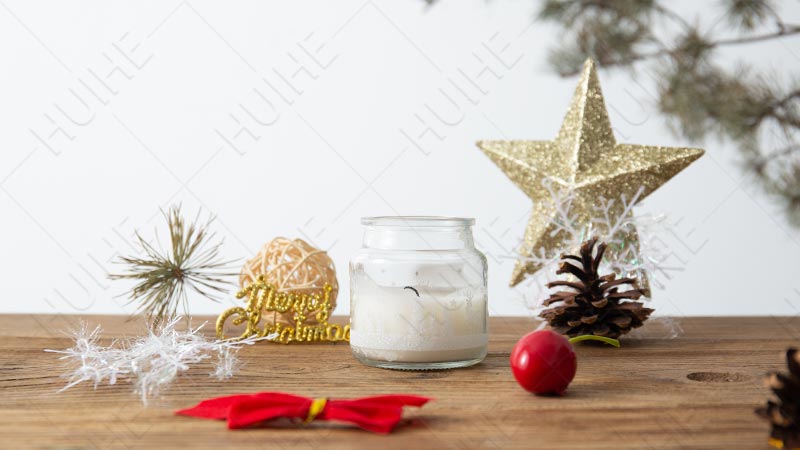
What Makes a Candle-Safe Glass Container?
Material Type (Soda Lime vs. Borosilicate)
Most commercial candle jars are made from soda-lime glass, which performs well when properly annealed and tested. Borosilicate glass, on the other hand, offers even higher heat resistance and better thermal stability but is typically used for premium lines due to higher cost. The key is not only the material itself but whether the glass is produced and treated for consistent heat performance.
Wall Thickness & Stress Distribution
A candle-safe container should have uniform wall thickness, usually in the 3–5 mm range. This prevents weak spots and helps the jar handle the heat from a burning flame. Even more important is how stress is distributed throughout the glass. Proper molding and controlled cooling allow the container to expand and contract safely during each burn cycle.
Heat-Shock Performance
Heat-shock resistance shows how well a container handles sudden temperature changes. Candle glass should withstand a quick shift from room temperature to high heat without cracking. Reliable candle containers go through thermal shock testing, where they are exposed to temperature differences that simulate real burning conditions. If a jar can’t pass this test, it should not be used for candles.
Reinforced Bottom Design
The bottom of a candle jar absorbs the highest temperature from the flame. A good container will have a stable, reinforced base that distributes heat evenly and reduces stress concentration. This design helps prevent breakage and supports long, consistent burning. Thin or uneven bottoms are a red flag and can lead to dangerous failures.

Testing Standards (Thermal Test, Drop Test)
Candle-safe glass should meet recognized testing standards such as thermal shock tests, stress tests, and drop tests. These evaluations make sure the container can handle real-world conditions — from high flame temperatures to handling during transport. Working with suppliers who follow ASTM, CE, or similar standards gives you peace of mind and ensures your candle containers are ready for commercial use.
Practical Guide: Choosing the Right Candle Glass for Your Product Line
Many businesses struggle to match the right glass container with the type of candle they are producing. Here’s a simple guide you can follow:
1. Glass Candle Container Sizing Guide (By Wax Type & Burn Time)
Choose jars that fit your candle’s needs to avoid performance issues:
- Soy wax (softer, slower-burning): Pair with 8–16oz jars (2–3mm wall thickness) for 20–50h burn times; 16–24oz jars (3mm thickness) for 50–100h burns.
- Beeswax (denser, hotter-burning): Opt for 6–12oz borosilicate glass jars (3mm thickness) to handle higher heat, even for shorter 20–30h burns.
- Paraffin wax (faster-burning): Use 10–20oz jars (2.5–3mm thickness) for 30–70h burns—ensure the jar’s diameter is 2–3x the wick size to prevent overheating.
2. Safety Use Mistakes to Avoid
Even the best glass jars can fail if misused—share these guidelines with your customers:
- Never heat glass jars directly over a flame (e.g., stovetop or campfire) — this bypasses the candle’s natural heat distribution and causes cracking.
- Don’t pour cold water on a hot jar to extinguish the candle—sudden temperature shock will shatter the glass.
- Always keep burning candles out of reach of children and pets, and place jars on a heat-resistant surface (not wood or plastic).
3. Procurement Pitfalls to Dodge
- Low-cost glass often uses recycled material with hidden impurities—these weaken the glass and increase cracking risk. HUIHE uses 100% virgin food-grade glass to eliminate this issue.
- Skip suppliers without CE/FDA certifications—exporting uncertified jars can lead to customs holds or fines. Our jars are fully certified for global markets, so you can ship with confidence.
- Avoid suppliers that can’t provide batch samples—testing a small batch first ensures the jars match your wax, wick, and branding before you place a large order.
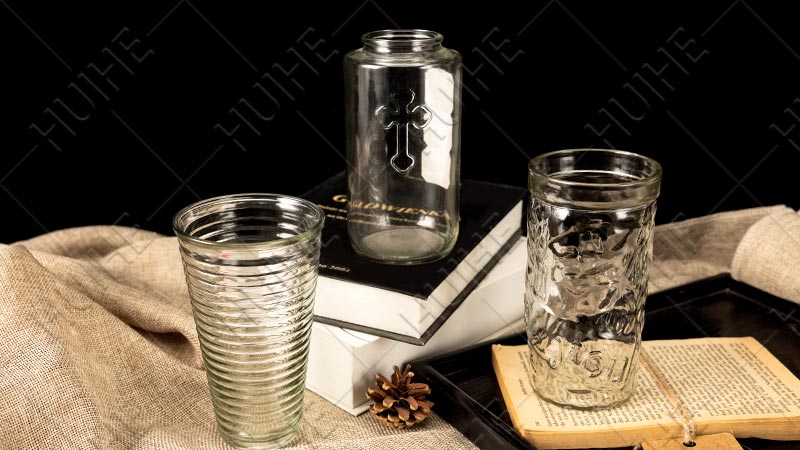
Conclusion
Selecting the right candle glass is not just about aesthetics—it’s a critical decision that impacts product safety, customer experience, and long-term brand reputation. Understanding proper glass materials, thickness, heat resistance, and structural integrity helps eliminate common risks like cracking or overheating. By partnering with reliable manufacturers that adhere to strict quality standards and offer professional guidance, brands can confidently develop candle lines that are both visually appealing and safe.
If you need support in choosing heat-tested containers or customizing candle jars for your product line, HUIHE PACK is here to help. We provide technical advice, product samples, and professional selection services tailored to your project’s unique needs.

FAQ
1. Can any glass jar be used for candles?
Not all jars are suitable for candles. Many food jars or thin glass containers are not designed for direct heat exposure and may crack during burning. Candle-safe glass must meet certain thickness, durability, and heat-resistance requirements.
2. What type of glass is best for candles?
Soda-lime glass with proper thickness and controlled manufacturing is the most commonly used material for candle containers. Heat-strengthened or specially tempered glass provides additional safety for larger or higher-temperature candles.
3. Why do candle jars break?
Common reasons include:
- Glass not designed for heat exposure
- Uneven glass thickness
- Air bubbles or micro-cracks in the material
- Excessive heat from oversized wicks
- Burning the candle too low, causing thermal stress at the base
4. How to prevent candle glass from cracking?
You can minimize risks by:
- Choosing heat-tested, candle-grade glass
- Using proper wick size and wax formula
- Avoiding thin or recycled food jars
- Ensuring uniform glass thickness
- Following safe burning instructions (e.g., stop using the candle when 1–1.5 cm wax remains)

